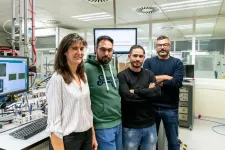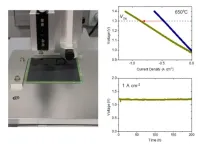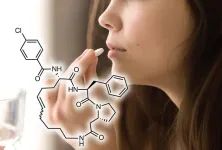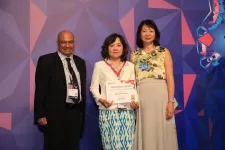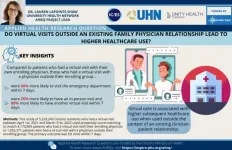(Press-News.org) (WASHINGTON, Dec. 28, 2023) – Lisocabtagene maraleucel (liso-cel), a CAR T-cell therapy, is a cost effective second line treatment for relapsed and refractory (hard to treat) diffuse large B-cell lymphoma (r/r DLBCL), according to a study published today in Blood Advances. The study is the first of its kind to incorporate healthcare expenses, societal productivity losses, and patient quality of life in assessing the drug’s cost-effectiveness.
"In our study, we incorporated the often-overlooked societal costs associated with cancer treatment, which are typically neglected in cost-effectiveness analyses that focus solely on the healthcare sector related-expenses," explained Mohamed Abou-el-Enein, MD, PhD, MSPH, an associate professor of medicine at the Keck School of Medicine at the University of Southern California and the senior author of the study. “Cancer treatments can diminish quality of life, causing work absences and challenges in managing everyday activities, especially among the elderly. Treatments that improve quality of life not only benefit the patient but also reduce these broader societal costs, which is an important aspect of our cost-effectiveness evaluation."
DLBCL, the most prevalent form of non-Hodgkin lymphoma, is a cancer that affects lymphocytes, a type of white blood cell. In cases where DLBCL does not respond to initial treatment or recurs within 12 months after treatment completion, the standard care protocol typically includes platinum-based chemotherapy, followed by high-dose chemotherapy and autologous stem cell transplantation. In 2022, the U.S. Food and Drug Administration (FDA) granted approval to liso-cel as a second-line treatment for DLBCL. However, the cost-effectiveness of liso-cel is currently a topic of debate among oncologists, especially considering the drug's steep price tag which increased from $410,300 to $447,227 between 2022 and 2023.
In this study, researchers performed a cost-effectiveness analysis of liso-cel for treating r/r DLBCL using a partitioned survival model, a common economic tool for assessing medical treatments across various stages of disease progression. They found that patients treated with liso-cel had an average life expectancy of 5.34 years and gained 3.64 quality-adjusted life years (QALYs), compared to the 2.47 years and 1.62 QALYs with standard care (SC). The cost-effectiveness of liso-cel, measured by the incremental cost-effectiveness ratio (ICER), was $99,669 per QALY from a healthcare sector perspective and $68,212 per QALY from a societal perspective. The ICER evaluates the additional cost required for each QALY gained, assuming a societal willingness to pay up to $100,000 per QALY. These figures indicate that liso-cel is a cost-effective treatment, staying below the $100,000 per QALY threshold.
An important aspect of the study is its modeling based on outcomes from the TRANSFORM trial, the pivotal study assessing the cost-effectiveness of liso-cel in second-line treatment. This approach closely mirrors the patient population from the TRANSFORM trial, thereby reducing bias in the results. The patient demographic typically involving patients aged 60, with a majority (57%) being male, and all having r/r DLBCL with a relapse occurring within 12 months of initial treatment. The treatment regimens were consistent with those used in the TRANSFORM trial.
Direct medical costs included in the analysis were comprehensive, covering CAR T-cell therapy procedures, chemotherapy, stem cell transplant, hospital admissions, ongoing monitoring, management of disease progression, and end-of-life care. This also encompassed the costs associated with treating adverse events. These costs were derived from published literature and public datasets. Societal costs considered lost productivity, including lost labor market earnings, the value of unpaid productivity and household activities, and out-of-pocket travel expenses. Notably, in terms of mortality-related lost labor earnings, liso-cel was associated with a loss of $110,608, which is lower than the $156,362 for SC. Additionally, both unpaid productivity loss and uncompensated household production costs were comparatively lower for liso-cel. These findings indicate that liso-cel offers economic benefits by reducing losses in both paid and unpaid labor sectors, compared to SC.
The authors' strict adherence to data from the TRANSFORM trial brings about a limitation in their study due to the lack of long-term follow-up data to be incorporated in their cost-effectiveness analysis. Moreover, the scenario analyses conducted, which looked at various time horizons, utility values, and list prices, reveal that maintaining liso-cel cost-effective at the $100,000 per QALY threshold might pose a challenge. This underlines the critical need to manage liso-cel's costs effectively to ensure its affordability and economic sustainability.
Looking ahead, Dr. Abou-el-Enein explains that their objective is to continue evaluating the cost-effectiveness of various CAR T-cell therapies. This information is crucial for making informed decisions about reimbursements and their integration into the healthcare system. He also stresses the significance of ongoing dialogue among clinicians, researchers, pharmaceutical manufacturers, and patients concerning the escalating costs of CAR-T cell therapy.
“This study demonstrates that CAR T-cell therapy is worth considering as a second line treatment for r/r DLBCL,” Dr. Abou-el-Enein said. “When deciding on what therapies to use in clinical practice, I think it is important that we do not shy away from these therapies solely because of their list price. We must keep our patients front and center in these decisions and continue to have conversations about how we can lower the price of CAR T-cell therapy and increase patient access to this life-saving treatment.”
# # #
Blood Advances (www.bloodadvances.org) publishes more peer-reviewed hematology research than any other academic journal worldwide and is an online only, open access journal of the American Society of Hematology (ASH), the world’s largest professional society concerned with the causes and treatment of blood disorders.
Blood Advances® is a registered trademark of the American Society of Hematology.
Contact:
Kira Sampson, American Society of Hematology
ksampson@hematology.org; 202-499-1796
END
This new method is based on the exsolution process activated by microwave radiation. Exsolution is a method of generating metallic nanoparticles on the surface of ceramic materials. "At elevated temperatures and in a reducing atmosphere (usually hydrogen), metal atoms migrate from the structure of the material to its surface, forming metal nanoparticles anchored to the surface. This anchoring significantly increases the strength and stability of these nanoparticles, which positively impacts the efficiency of these catalysts," explains Beatriz García Baños, a researcher in the Microwave Area of the ITACA Institute at the UPV.
In the work now ...
Brigham researchers’ findings from next-generation sequencing suggest that revising current cancer care guidelines could allow approximately 6,000 more patients in the U.S. to benefit from immunotherapy treatment each year
Immunotherapy is a highly effective treatment for patients whose cancers harbor mismatch repair deficiency, and a new study identifies more cancer patients who could benefit from this form of therapy. Investigators from Brigham and Women’s Hospital, a founding member of the Mass General Brigham healthcare system, found that nearly six percent of endometrial cancer patients and one percent of colorectal cancer patients with mismatch repair deficiency were ...
Health care systems in the United States have gradually embraced the concept that mental health should be treated on par with physical health, especially in light of increased rates of anxiety and depression during and after the COVID-19 pandemic.
To improve access to mental health treatment, many Medicaid programs have required their managed care organizations to pay for behavioral health and physical health together. That’s in contrast to the traditional approach in which behavioral health, including treatment for substance use disorders, was “carved out” ...
Scientists have devised a new way to identify habitable planets and potentially inhabited planets, by comparing the amount of carbon dioxide in their atmosphere, to neighbouring planets.
An international team of researchers from the University of Birmingham (UK), the Massachusetts Institute of Technology (MIT) (US) and elsewhere, have shown that if a planet has a reduced amount of CO2 in its atmosphere compared to neighbouring planets, it suggests there is liquid water on that planet’s surface. The drop in CO2 levels implies ...
Green hydrogen can be produced through water electrolysis technology, which uses renewable energy to split water into hydrogen and oxygen without emitting carbon dioxide. However, the production cost of green hydrogen is currently around $5 per kilogram, which is two to three times higher than gray hydrogen obtained from natural gas. For the practical use of green hydroten, the innovation in water electrolysis technology is required for the realization of hydrogen economy, especially for Korea where the utilization ...
A few years ago, the World Health Organization estimated that blood poisoning, or sepsis, is involved in one in five deaths in the world. 11 million people die from sepsis each year, of which nearly 3 million are children.
This is also a problem in Norway, with thousands of people affected every year.
“Sepsis is a severe immunological overreaction to an infection. It causes the body’s organs to fail,” says Nina Vibeche Skei. She is a doctoral research fellow at the Norwegian University of Science and Technology (NTNU) and a senior anaesthetist ...
For decades, a substantial number of proteins, vital for treating various diseases, have remained elusive to oral drug therapy. Traditional small molecules often struggle to bind to proteins with flat surfaces or require specificity for particular protein homologs. Typically, larger biologics that can target these proteins demand injection, limiting patient convenience and accessibility.
In a new study published in Nature Chemical Biology, scientists from the laboratory of Professor Christian Heinis at EPFL have achieved a significant milestone in drug development. Their research ...
The Asian Fund for Cancer Research (AFCR) is pleased to announce that Degron Therapeutics was selected as the winner of the 2023 BRACE Award Venture Competition.
AFCR’s BRACE (Bridging Research from Academia to Cancer Entrepreneurship) Award Venture Competition is designed to support and accelerate oncology innovations on their path toward commercialization, with the ultimate goal of improving outcomes for patients affected by cancer globally. AFCR aims to support the winners of the BRACE Award with funding resources, advisory experts, and access to our global network of key opinion leaders in cancer research.
The winner of the BRACE ...
Embargoed for release: December 27, 2023, 2:00 PM ET
Key points:
Researchers estimated that Facebook, Instagram, Snapchat, TikTok, X (formerly Twitter), and YouTube collectively derived nearly $11 billion in advertising revenue during 2022 from U.S. youth, who are vulnerable to negative mental health outcomes.
The study is the first to offer estimates of the number of youth users on these platforms and how much annual ad revenue is attributable to them.
According to the researchers, the study’s ...
Toronto, ON, December 27, 2023 – Compared to patients who had a virtual visit with their own family doctor, those who received virtual care from a doctor outside of their family care team were 66 percent more likely to visit the emergency department within seven days, according to new research.
The study, led by researchers at the University Health Network (UHN), Unity Health Toronto, and ICES, also showed that patients receiving virtual care outside of an existing family doctor-patient relationship were 25 percent more likely to have an in-person visit and 88 percent more likely to have another virtual visit within seven days.
“This study sheds light on how different types ...
